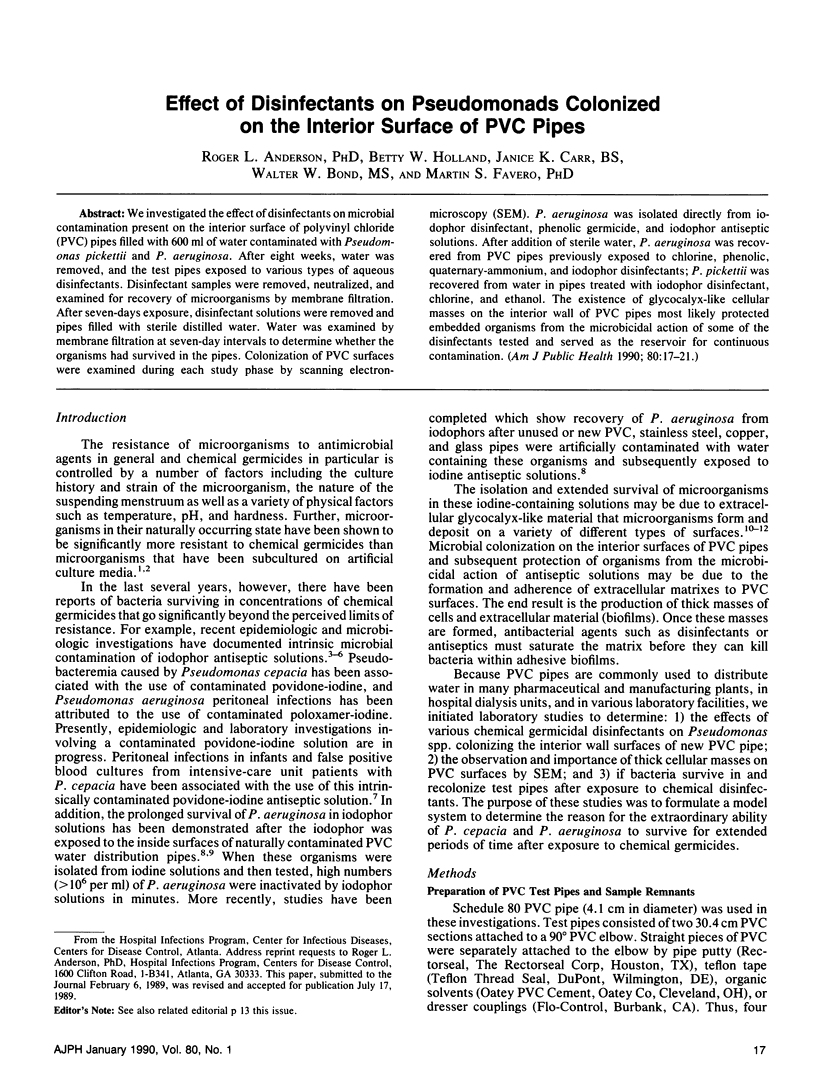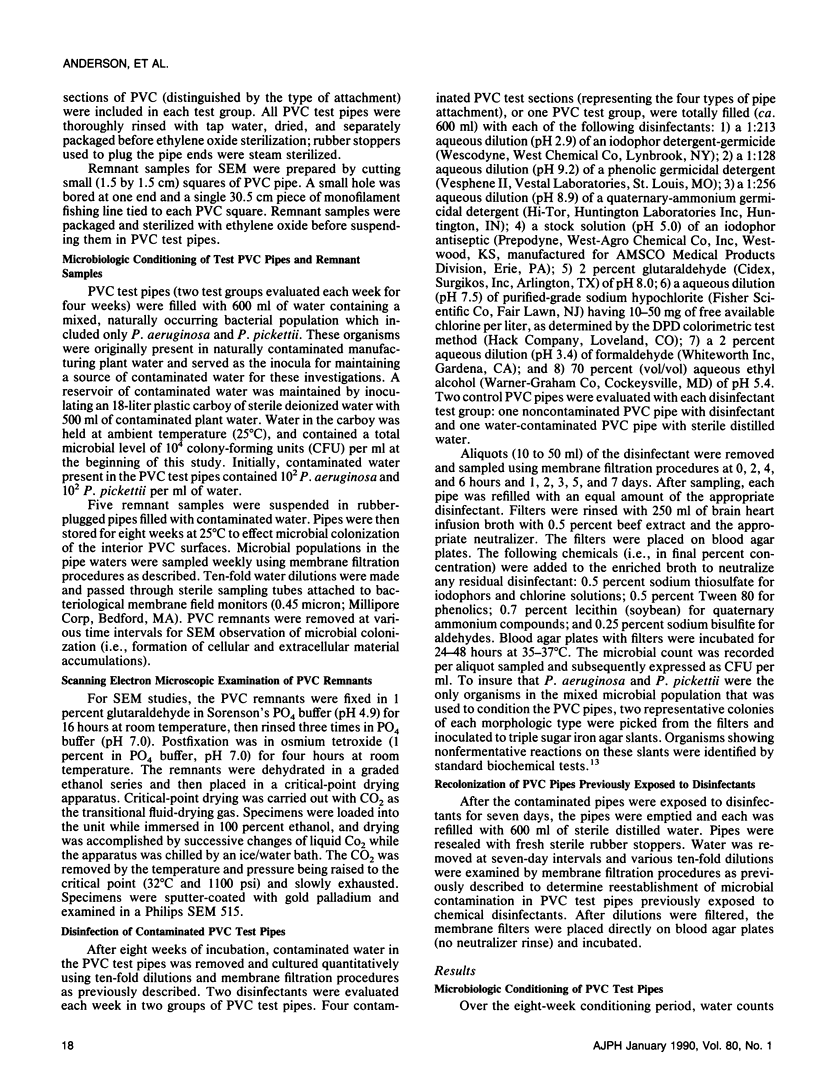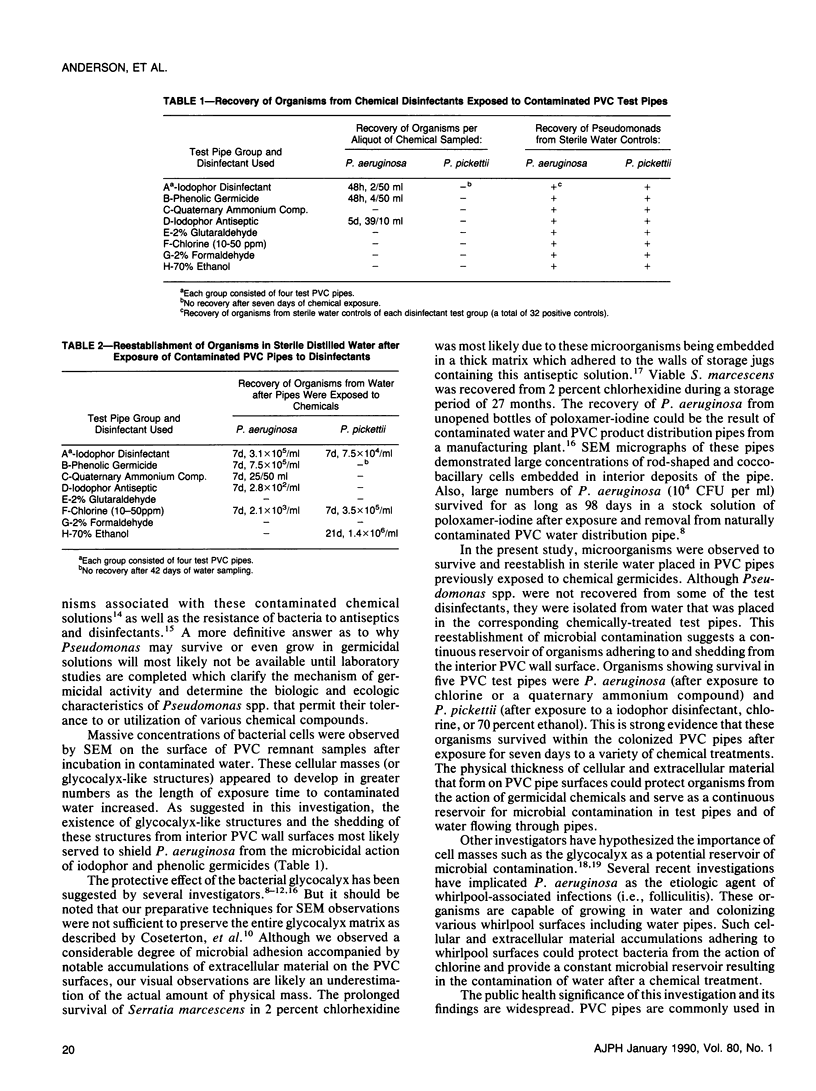Abstract
We investigated the effect of disinfectants on microbial contamination present on the interior surface of polyvinyl chloride (PVC) pipes filled with 600 ml of water contaminated with Pseudomonas pickettii and P. aeruginosa. After eight weeks, water was removed, and the test pipes exposed to various types of aqueous disinfectants. Disinfectant samples were removed, neutralized, and examined for recovery of microorganisms by membrane filtration. After seven-days exposure, disinfectant solutions were removed and pipes filled with sterile distilled water. Water was examined by membrane filtration at seven-day intervals to determine whether the organisms had survived in the pipes. Colonization of PVC surfaces were examined during each study phase by scanning electron-microscopy (SEM). P. aeruginosa was isolated directly from iodophor disinfectant, phenolic germicide, and iodophor antiseptic solutions. After addition of sterile water, P. aeruginosa was recovered from PVC pipes previously exposed to chlorine, phenolic, quaternary-ammonium, and iodophor disinfectants; P. pickettii was recovered from water in pipes treated with iodophor disinfectant, chlorine, and ethanol. The existence of glycocalyx-like cellular masses on the interior wall of PVC pipes most likely protected embedded organisms from the microbicidal action of some of the disinfectants tested and served as the reservoir for continuous contamination.
Full text
PDF




Images in this article
Selected References
These references are in PubMed. This may not be the complete list of references from this article.
- Anderson R. L., Berkelman R. L., Mackel D. C., Davis B. J., Holland B. W., Martone W. J. Investigations into the survival of Pseudomonas aeruginosa in poloxamer-iodine. Appl Environ Microbiol. 1984 Apr;47(4):757–762. doi: 10.1128/aem.47.4.757-762.1984. [DOI] [PMC free article] [PubMed] [Google Scholar]
- Berkelman R. L., Anderson R. L., Davis B. J., Highsmith A. K., Petersen N. J., Bond W. W., Cook E. H., Mackel D. C., Favero M. S., Martone W. J. Intrinsic bacterial contamination of a commercial iodophor solution: investigation of the implicated manufacturing plant. Appl Environ Microbiol. 1984 Apr;47(4):752–756. doi: 10.1128/aem.47.4.752-756.1984. [DOI] [PMC free article] [PubMed] [Google Scholar]
- Berkelman R. L., Lewin S., Allen J. R., Anderson R. L., Budnick L. D., Shapiro S., Friedman S. M., Nicholas P., Holzman R. S., Haley R. W. Pseudobacteremia attributed to contamination of povidone-iodine with Pseudomonas cepacia. Ann Intern Med. 1981 Jul;95(1):32–36. doi: 10.7326/0003-4819-95-1-32. [DOI] [PubMed] [Google Scholar]
- Carson L. A., Favero M. S., Bond W. W., Petersen N. J. Factors affecting comparative resistance of naturally occurring and subcultured Pseudomonas aeruginosa to disinfectants. Appl Microbiol. 1972 May;23(5):863–869. doi: 10.1128/am.23.5.863-869.1972. [DOI] [PMC free article] [PubMed] [Google Scholar]
- Carson L. A., Petersen N. J., Favero M. S., Aguero S. M. Growth characteristics of atypical mycobacteria in water and their comparative resistance to disinfectants. Appl Environ Microbiol. 1978 Dec;36(6):839–846. doi: 10.1128/aem.36.6.839-846.1978. [DOI] [PMC free article] [PubMed] [Google Scholar]
- Costerton J. W., Geesey G. G., Cheng K. J. How bacteria stick. Sci Am. 1978 Jan;238(1):86–95. doi: 10.1038/scientificamerican0178-86. [DOI] [PubMed] [Google Scholar]
- Costerton J. W., Irvin R. T., Cheng K. J. The bacterial glycocalyx in nature and disease. Annu Rev Microbiol. 1981;35:299–324. doi: 10.1146/annurev.mi.35.100181.001503. [DOI] [PubMed] [Google Scholar]
- Craven D. E., Moody B., Connolly M. G., Kollisch N. R., Stottmeier K. D., McCabe W. R. Pseudobacteremia caused by povidone-iodine solution contaminated with Pseudomonas cepacia. N Engl J Med. 1981 Sep 10;305(11):621–623. doi: 10.1056/NEJM198109103051106. [DOI] [PubMed] [Google Scholar]
- Favero M. S. Iodine--champagne in a tin cup. Infect Control. 1982 Jan-Feb;3(1):30–32. doi: 10.1017/s0195941700057076. [DOI] [PubMed] [Google Scholar]
- Favero M. S. Whirlpool spa-associated infections: are we really in hot water? Am J Public Health. 1984 Jul;74(7):653–655. doi: 10.2105/ajph.74.7.653. [DOI] [PMC free article] [PubMed] [Google Scholar]
- Marrie T. J., Costerton J. W. Prolonged survival of Serratia marcescens in chlorhexidine. Appl Environ Microbiol. 1981 Dec;42(6):1093–1102. doi: 10.1128/aem.42.6.1093-1102.1981. [DOI] [PMC free article] [PubMed] [Google Scholar]
- Parrott P. L., Terry P. M., Whitworth E. N., Frawley L. W., Coble R. S., Wachsmuth I. K., McGowan J. E., Jr Pseudomonas aeruginosa peritonitis associated with contaminated poloxamer-iodine solution. Lancet. 1982 Sep 25;2(8300):683–685. doi: 10.1016/s0140-6736(82)90712-7. [DOI] [PubMed] [Google Scholar]
- Russell A. D., Hammond S. A., Morgan J. R. Bacterial resistance to antiseptics and disinfectants. J Hosp Infect. 1986 May;7(3):213–225. doi: 10.1016/0195-6701(86)90071-x. [DOI] [PubMed] [Google Scholar]
- Rutala W. A., Cole E. C. Antiseptics and disinfectants--safe and effective? Infect Control. 1984 May;5(5):215–218. doi: 10.1017/s0195941700060136. [DOI] [PubMed] [Google Scholar]



